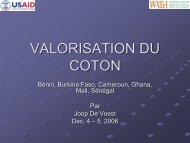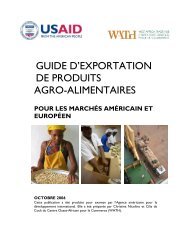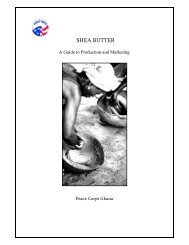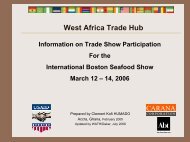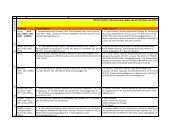A Brief Introduction to Textile Processing - AGOA Export Toolkit
A Brief Introduction to Textile Processing - AGOA Export Toolkit
A Brief Introduction to Textile Processing - AGOA Export Toolkit
Create successful ePaper yourself
Turn your PDF publications into a flip-book with our unique Google optimized e-Paper software.
3. Aligning fibers and forming loose web or mass of fibers<br />
4. Elongating mass of fibers<br />
5. Spinning, twisting <strong>to</strong> lock fibers <strong>to</strong>gether<br />
6. Plying two or more yarns in<strong>to</strong> one.<br />
Step 1. Cleaning. All natural fibers must be cleaned and separated before processing. Seeds (e.g.<br />
cot<strong>to</strong>n) must be removed, dirt and other foreign matter must be removed (plant and animal fibers).<br />
<strong>Processing</strong> fibers without properly or thoroughly cleaning them causes very poor quality yarn not<br />
suitable for apparel. Bales of raw fiber are opened and fed in<strong>to</strong> machines that separate dirt and debris<br />
from fiber.<br />
Step 2. Blending. In order <strong>to</strong> achieve a better combination of desirable characteristics in a yarn or<br />
fabric, manufacturers often blend two or more fiber types (or lengths) <strong>to</strong>gether in<strong>to</strong> the one yarn.<br />
This is generally done at the fiber stage. Fibers are usually fed in<strong>to</strong> a large (2,000 kg or larger)<br />
blending machine that mixes the fibers for an even distribution of each fiber type and / or length.<br />
Step 3. Alignment. Before fibers can be formed in<strong>to</strong> a yarn, they<br />
must be aligned in parallel (or nearly parallel) orientation. Shorter<br />
fibers give significantly less strength <strong>to</strong> a finished yarn, so<br />
manufacturers maximize the length of each fiber by straightening it<br />
and laying it parallel <strong>to</strong> other fibers before beginning the yarn<br />
formation. Once aligned, the loose fibers form a wide, thick, fluffy<br />
mat with little or no strength. These mats of fiber are then pulled<br />
gently in<strong>to</strong> a loose, rope – like cylinder a couple of centimeters in<br />
diameter, (about the diameter of a medium carrot) called a sliver. Above: slivers feeding in<strong>to</strong> roving frame<br />
Step 4. Elongating. In order <strong>to</strong> give yarn strength, the slver must be<br />
further elongated and some twist must be imparted <strong>to</strong> hold the<br />
individual fibers <strong>to</strong>gether more tightly. The sliver is pulled (drawn) and<br />
twisted down <strong>to</strong> a roving, the size of an ordinary pencil.<br />
Step 5. Spinning. The roving is drawn again, twisted tightly, forming<br />
a continuous thread – like yarn with substantially more strength than<br />
the roving. Different methods may be used for spinning, but ring –<br />
spinning and open – end spinning are the most common. After spinning,<br />
yarn is wound on<strong>to</strong> a thick cardboard or plastic cone, or on<strong>to</strong> a bobbin,<br />
depending upon how it will be used.<br />
Right: Ring spinning frame<br />
producing cot<strong>to</strong>n yarn<br />
Left: cone of yarn<br />
Step 6. Plying. For greater strength, thickness, and at times certain other design characteristics, two<br />
or more yarns may be twisted <strong>to</strong>gether. Each individual yarn is then referred <strong>to</strong> as a “ply.” The<br />
number of plys is often noted in describing the yarn (e.g. a singles yarn denotes it has not been plyed;<br />
a two-ply yarn indicates two yarns have been twisted <strong>to</strong>gether in<strong>to</strong> one,)<br />
Prepared by Margaret Bishop and Brent Smith for the West Africa Trade Hub 8/04 5



